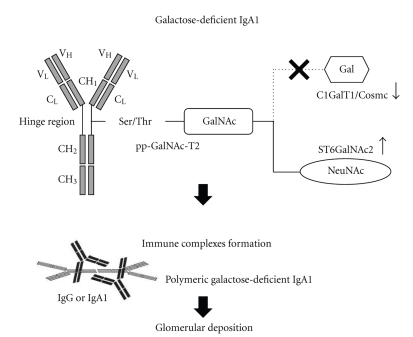Figure 1.
The galactose-deficient IgA1 molecule and the immune complexes formation in the pathogenesis of IgAN. IgA1 has characteristic hinge regions between the CH1 and CH2 domains (CH, the constant regions of the heavy chain), which contain at least six serine (Ser) or threonine (Thr) residues as O-linked glycosylation sites. In the first step, the enzyme polypeptide N-acetylgalactosaminyltransferase (pp-GalNAc-T2) facilitates the attachment of N-acetylgalactosamine (GalNAc) to these residues. In the second step, the IgA1 glycosylation is extended in two ways. One is the binding of N-acetylneuraminic acid (NeuNAc) to GalNAc through the action of the enzyme N-acetylgalactosamine-specific α2,6-sialyltransferas (ST6GalNAc2) [17]. The other is galactose (Gal) connection to GalNAc through the enzyme core 1 β1,3 galactosyltransferase (C1GalT1) and core-1-β3-Gal-T specific molecular chaperone (Cosmc) [18]. The imbalance between those activities may promote galactose-deficient IgA1 production [10, 18]. Galactose-deficient IgA1 is aggregated with antiglycan IgG or IgA1 antibodies, resulting in formation of immune complexes [13], which may escape the normal catabolism in liver and also accumulate with high affinity in glomerular mesangium.

